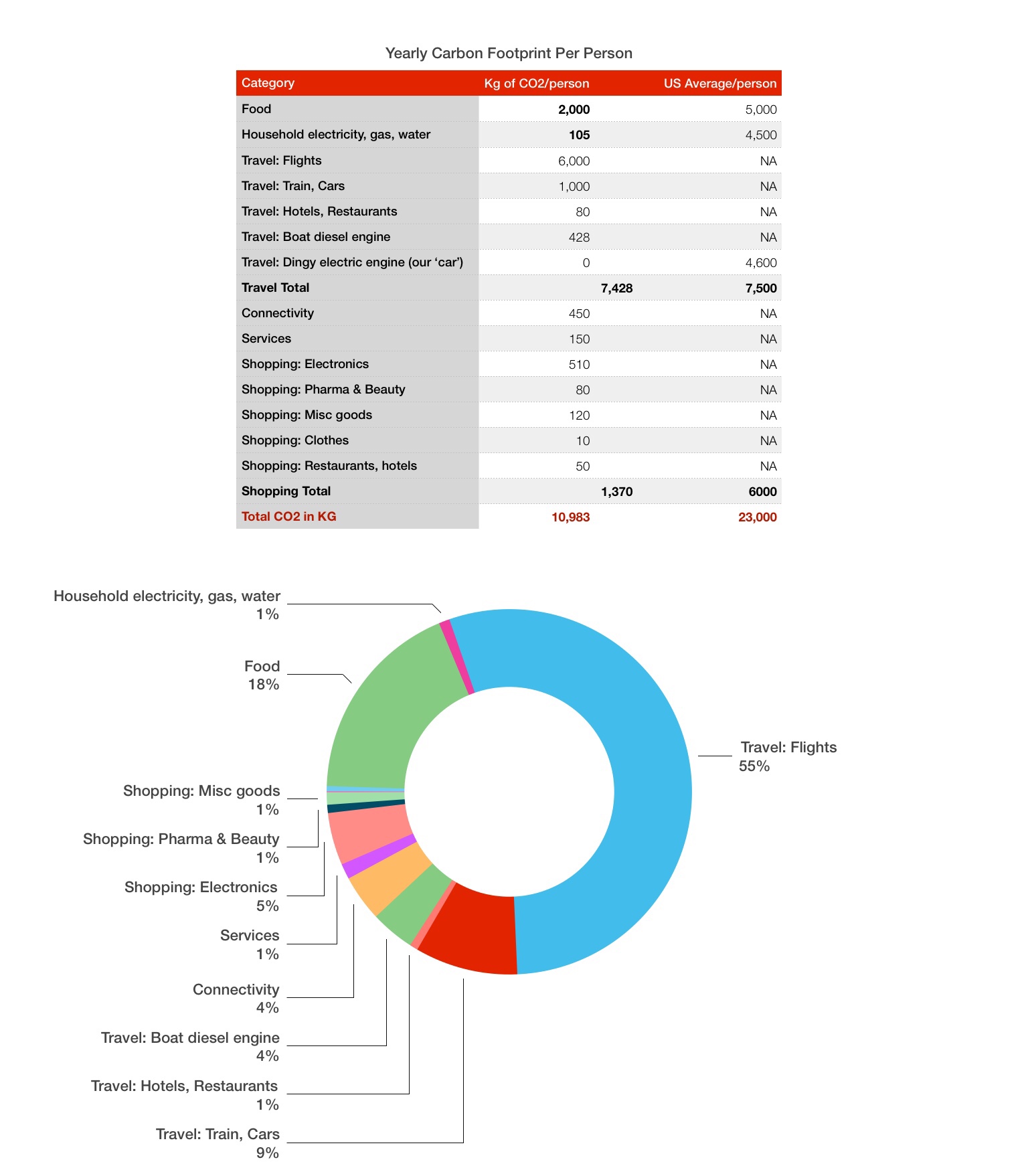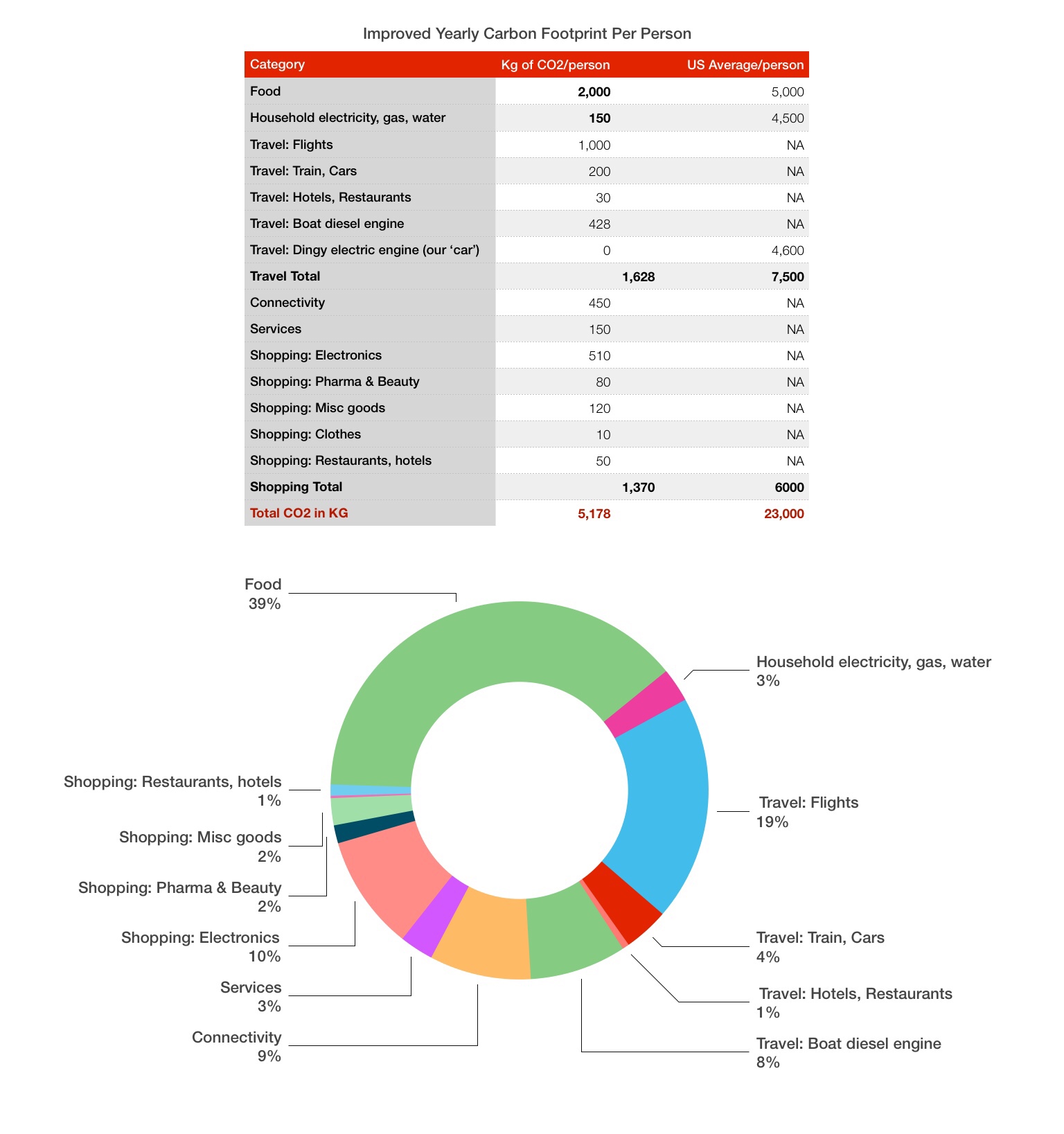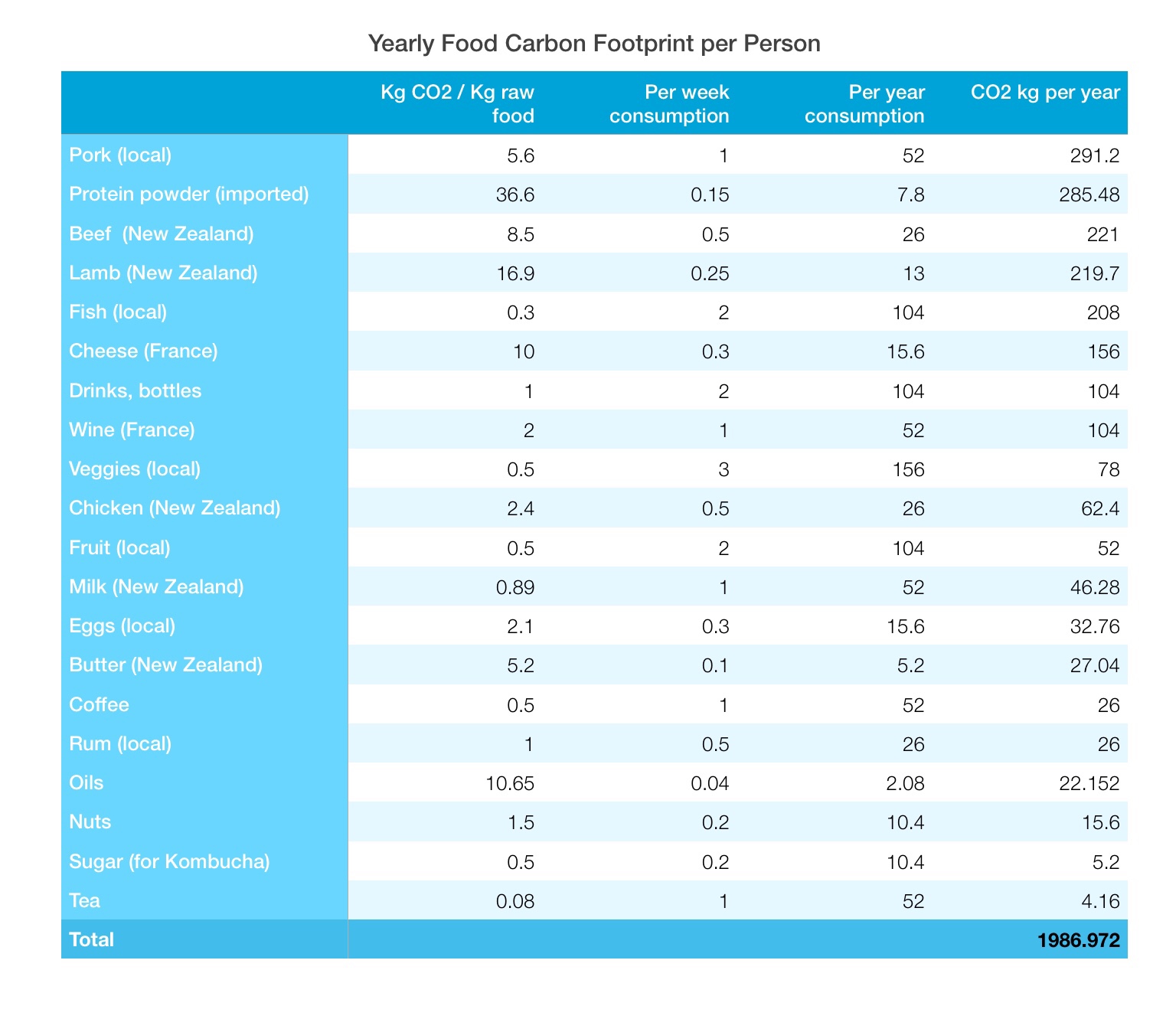In the last couple of weeks I’ve been thinking more and more about our personal Carbon footprint. From the not-yet-tested assumption that our solar and wind powered cruising lifestyle should be low-footprint, to several sundowner conversations about diet choices, cows, and lithium battery production, to several articles about global warming, Amazon fires, food production, and Greta Thunberg‘s arrival in New York on a sailboat, the topic keeps following me around. So what’s a curious cruiser to do but start reading some research papers and put together some spreadsheets? Once a PM, always a PM, or so they say… right?
The carbon footprint calculators on the internets seem to vary wildly in terms of accuracy and granularity of input and output. They are a good place to start, but I found myself wanting more accurate data that wasn’t cookie-cut to the big-house-with-a-white-picket-fence model. After all, we live in French Polynesia in a floating tiny home and drive around an electric dingy as opposed to a car. If you are curious about your footprint and looking for a place to start, this one and this one don’t suck, but I ended up pretty much tailoring and modifying most numbers based on more granular inputs and more recent research which is readily available online.
Highlights: I was shocked to learn how much CO2 we contributed last year based on our international travel due to long flights half way around the world, but not surprised to learn that our animal-protein based diet has the same carbon footprint as the US average vegan diet due to our attention on how we source the meats and preference for non-processed foods. And I was chagrined to realize that even with our solar green living, we still averaged twice as much as the global average.
But let me get into the details. Below is a table and diagram detailing the last 12 months in CO2 impact:

As you can see here, each of us totaled about half of the US average, but twice the 5 metric ton worldwide carbon footprint. I was rather deflated to realize that most of that waste (64%!) came from our flights to Europe, and from zig-zagging around the US to visit friends during our cruising interlude. All the carbon saved on not having a car, and driving instead in a solar powered electric dingy was blown on flights. One of the things I love most about our lifestyle (besides the turtles 🐢 and whales 🐳 and fishes 🐠🐬🐙🐡) is the time we get to travel and visit loved ones, who happen to be almost equally distributed around the world from where we are in French Polynesia. Hence the Carbon Dilemma from the title: to fly or not to fly, or rather how long and how often to fly! I’m not ready to give up flying, but I hope I can plan and budget flights more efficiently in the future.
You can’t improve what you don’t measure, so now that I have a handle on our CO2 emissions, I’m hoping we can halve our next year’s carbon footprint and make it look something more like this:

The biggest savings would come from limiting ourselves to one flight to Hawaii or West Coast US, less land travel while we are there and travel by boat/train otherwise.
On the other hand, our Household footprint will go up due to the purchase of 500 Ah of lithium batteries, which I amortized over 10 years. The full carbon impact of manufacturing and shipping the lithium batteries would be 1050 kg of CO2, about the same impact as a flight to California and back from here. We are giving away our current batteries, which still work at reduced capacity, to a friend we made here who is building his own organic sustainable farm. So maybe we’ll get some carbon dividends in coconuts, tomatoes and cucumbers in the future. We will also give up LPG cooking on the BBQ and move to our existing electric BBQ, which will give us some additional savings.
Our overall shopping footprint is pretty small compared to average. There are not may things to buy here, and there is no Amazon. Most of the carbon budget you see there is spent on boat parts. I had already ‘detoxed’ from shopping two years ago when we moved to Hawaii and I took a pledge to not buy anything I couldn’t reuse or borrow for one year. The habit stuck, and I’m still happily using my old collection of bikinis, dresses, and sandals, with the occasional pareo thrown in.
One thing you will notice is that our electronics and communications footprint is high in the category. This is due to the fact that we run our yacht management business Quartermaster online, and rely on satellite connectivity for half of the time which tends to be very costly (because of rockets 🚀 🛰 and stuff). We also constantly need new hardware. Last year it was phones and tablets, next year will be most likely a new laptop.
It’s not the Cow 🐮, its the How
With our target footprint for next year reduced by half, the next significant portion of our CO2 emissions becomes the food we consume. This is ‘normal’ for most people and living things in general, unless you own a personal jet (you know who you are!).
Still, taking a look at what we eat, how it gets produced, transported, refrigerated, cooked, and how we manage the waste is a very good way to optimize our carbon footprint.
The US average carbon footprint for a omnivore diet is 5000 kg CO2 per person. There are a lot of opinions out there of what we should eat to achieve a lower carbon footprint – I will leave you the ‘pleasure’ of googling them 😈. Before getting too far down the rabbit hole, I recommend reading this great article on The New Food Economy site on how It’s not the Cow, it’s the How (thanks @janamc for guiding me to it!) and drawing your own conclusions.
Below is our individual yearly food carbon footprint on Bella Marina. You will notice we manage to stay around the same figure quoted for a vegan diet in the US, although we base our meals around animal protein.

First, let me say that I am an unapologetic meat lover. I love love love a good steak ♥️🥩, I consider myself a burger 🍔 connoisseur, and can grill the meanest lamb chops for miles. But I also savour a good pork chop, absolutely love the fresh ahi tuna 🐟 we get in French Polynesia and the local Poisson Cru dish, and have recently rediscovered chicken 🍗.
I also like to think I am a discerning consumer who can make informed green choices, which is why I don’t eat steak every day (anymore… ahem). Here in French Polynesia we buy beef and lamb from New Zealand, which turns out have a much smaller carbon footprint than average even when not taking into consideration grass fed, free range animals farmed in a regenerative way. We limit our beef and lamb intake to once or twice a week, and choose wildly caught tuna, local pork, or chicken for the rest of the meals. More than half of our meals come from locally caught wild fish, and sometimes when we’re lucky from personally caught or speared fish 🎣 🐟 . We also fast one day of the week, mainly for health reasons (it’s a thing), but it helps with the old carbon too.
One thing I realized by researching these values is that lamb is significantly more carbon intensive than even beef, contrary to my previous misconceptions, so we’ll be limiting that in the future even more. Our protein powder is also pretty heavy on the CO2, but it’s such an important part of the way we train and eat to achieve the desired protein intake for recovery, that it would be hard to replace. It’s also super easy to store lots of when we sail away to remote destinations like the Tuamotus Archipelago, so I don’t think we’ll be giving that up soon.
We buy most of our veggies and fruit at the local stands and farmer’s markets, just like we did in Hawaii. It’s interesting to think that when we lived in Hawaii, I was able to also source beef, lamb, venison, pork, and chicken, direct from local farms that followed regenerative zero-carbon production practices, so our food carbon footprint was much lower. On the other hand, we drove a car to the market, and lived on the dock, so I think it was a wash.
Turns out that in the US, as much as 30% of the food carbon footprint comes from food waste. We manage a zero food waste boat, and as anyone who has seen me attack a chicken leg will attest, there is usually barely anything left to compost at the end of any meal.
The other components to take into consideration are travel from store to home, refrigeration, and cooking. We go everywhere (slowly!) including the grocery store by electric dingy engine. Our refrigeration is 100% driven by solar, and cooking is too. Last year we still used our gas BBQ, but going forward we are moving to fully electric/solar.
I hope you enjoyed our Carbon story!
Drop me a note @svbellamarina if you have questions or your own story to share.
